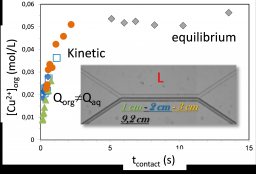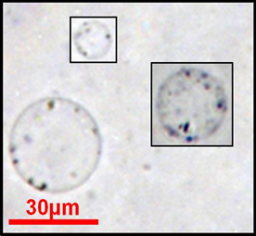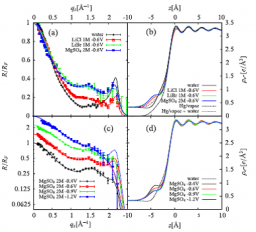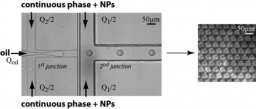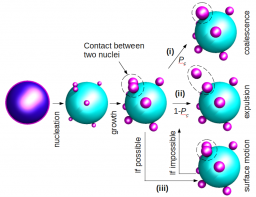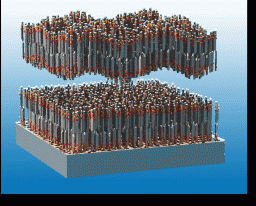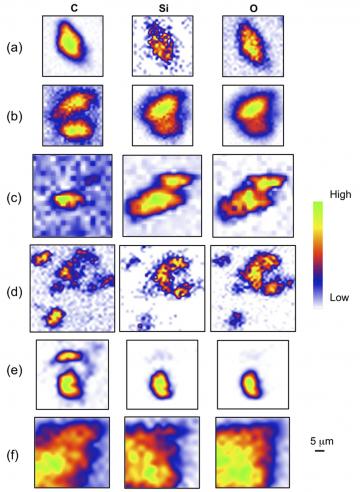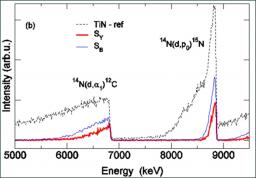2013
« Back to the Group page « Back to the Oxides page
Domain walls are intrinsic to ferroic materials. Long considered as understood, it is only recently, thanks to atomic-resolution studies using transmission electron microscopy (TEM) or atomic force microscopies (AFM, c-AFM, PFM etc.) that their real structural and electronic complexity has been revealed. Based on this, a new paradigm of ferroic devices is now envisaged where the domain walls, rather than the domains, are the active element. This field has been coined “Domain boundary engineering” or “Domain wall nanoelectronics”.
Photoferroelectrics are materials with both photoelectric and ferroelectric properties. As correlated-electron materials, they are attracting increasing interest because of their high technological potential. Recent reports show that low conversion efficiencies can be counterbalanced by large, above-band gap photo-voltages in complex multiferroic oxides and the fundamental role of the potential difference across domain walls.
More detailed and quantitative knowledge of its structural, electronic and chemical nature is necessary. Fundamental questions on the crystal structure and the electronic structure in the vicinity of the domain wall, as well as their behavior under illumination remain to be elucidated.
« Back to the Group page « Back to the Oxides page
Operational interfaces require knowledge of the interface response to applied bias. The electronic structure near the electrode will be determined by a combination of the above phenomena. For example, bias can induce the formation of filaments of oxygen vacancies or the migration of the latter towards electrodes as in resistive switching, whereas in tunnel regime capacitors atomic distortions can change under bias via the inverse piezoelectric effect.
Phenomenological and first-principles-based theoretical approaches have been deployed to understand the electronic structure at the interface under polarization. Classical semiconductor theory of the metal/insulator interface applied to FE capacitors, including the effect of polarization on band line-up and transport, describes charge injection in terms of the interface whereas the leakage current may be bulk limited. Theory has also shown that the local chemistry at the electrode/FE interface can enhance ferroelectricity. Dissimilar electrodes can induce a built-in electric field in the FE film. Extensive work on FE tunnel junctions has demonstrated the crucial role of the interface chemistry on tunneling probabilities. First principle calculations even predict an ohmic barrier but this may be due to the underestimation of the band gap. Knowledge of the microscopic layer polarization is vital because the interface induced changes of the electronic structure are expected to take place over a 1-2 nanometers.
In the framework of an internal CEA program dedicated to the liquid-liquid extraction for nuclear waste treatment (or primary extraction of uranyl), we have fully characterized the structure of the organic phase with its influence on the phase stability[1],[2] and more recently on the extraction efficiency[3]. Extraction is related to solubilization properties[4] where surfactant and hydrotrope can be used in closed connection to enhance the transfer[5]. In such processes, the liquid-liquid interface plays a key role even though its specific influence is not fully understood. Recently, we took benefit of microfluidic tools to control the interface by making the interfacial reactions predominating over bulk ones. Dedicated home-made chips have shown the possibility to follow kinetic but also to control the shearing properties of the interface
[1] Chapter 7 for Ion Exchange and Solvent Extraction F. Testard, P. Bauduin, L. Berthon, Th. Zemb. Ed B. Moyer, CRC Press, chap 7, P381 (2009).
[2] Berthon L, Testard F, Martinet L, Zemb T, Madic C., C. R. Chimie (2010), 13 1326–1334
[3] Dourdain, S; Hofmeister, I; Pecheur, O; Dufreche, JF; Turgis, R; Leydier, A; Jestin, J; Testard, F; Pellet-Rostaing, S; Zemb, T Langmuir (2012), 28 11319-11328.
[4] Kunz, W., Testard, F., Zemb, Th., Langmuir, (2009), 25(1), 112-115.
[5] Bauduin, P., Zemb, Th., Testard, F., J. Phys. Chem. B (2008) 112, 12354-12360.
Carbonated mineralization as carried out by living organisms like seashells is a very intriguing process leading to crystalline materials that diffract like single crystals while adopting very sophisticated shapes. Nacre is a paradigmatic example of biomineralization, made of water-insoluble organic compartments filled with a CaCO3 mineral phase. We successively considered two model systems to mimic the influence of an organic template on mineralization: first, β-sheet peptide monolayers at the air-water interface and then giant unilamellar polymer vesicles.
Concerning the first model system, two different peptidic sequences, named LSFD and LDFD (respectively 12 and 11 amino-acid long), were designed and evaluated with respect to their ability to form β-sheet layers at the air-water interface[1] and to induce a specific CaCO3 crystallization by selecting the nucleated polymorph and/or its crystallographic orientation.[2] Although the two sequences exhibit a β-sheet conformation at the air-water interface and form 2D crystalline domains, they show unable to direct the mineralization: the selected crystalline polymorph is switched from calcite to vaterite when the interface is covered by any of the two peptidic films, but probably owing to a kinetic effect. Moreover, vaterite crystals appear as a 3D powder with no preferred orientation with respect to the organic “template”. Surprisingly, the Langmuir film made from the more acidic peptide (LDFD) remains stable upon mineralization whereas the LSFD peptide film gets destabilized, likely through an adsorption of the peptides on the growing crystallites.
Within the ANR project ANR-06-BLAN-0276 "SISCI" (Spécificité Ionique dans les Systèmes Colloïdaux et Interfaciaux), we have explored the specific local ionic distributions in water in the vicinity of interfaces between aqueous electrolytes and external media.
Three different X-ray reflectivity techniques have been developed[1]. (i) The air-water interface has been investigated using grazing incidence x-ray fluorescence for different alkali-halide solutions[2]. The measured integrated amount of desorbed ions follows a Hofmeister series, in agreement with the surface tension behavior, and is interpreted in terms of ion-surface interaction potentials. (ii) The spatial ion distribution has been resolved at the sub-nanometer level using x-ray standing waves at the interface with a multilayer silica substrate. (iii) x-ray reflectivity analysis of polarized liquid mercury surface in contact with aqueous electrolyte has shown how the Hg-surface layering and the local ionic profiles depend on both applied potential and ion nature[3].
Emulsions of two immiscible fluids stabilized with solids particles, called Pickering emulsion, have been studied since the early twentieth century and the pioneering works of Ramsden[1] and Pickering[2] The irreversible adsorption of particles at the interface of the two phases gives original properties of these emulsions. Such emulsions are of primary interest in the food, cosmetics industry and oil recovery. Although it is now clear that the stabilization mechanism comes from the partial wettability of the nanoparticles by the two emulsion phases, the interface structures for such a stability mechanism is not well understood. There is a need of making a Pickering emulsion model system where the nanoparticles are well controlled as well as the emulsion size. The LIONS laboratory has developed a microfluidics platform (Fig.6) which allows preparing monodisperse tunable Pickering emulsion starting from monodisperse silica nanoparticles (NPs) of 7nm radius.
Hybrid organic-inorganic nanoparticles with well-controlled morphology are currently of great research interest. Synthetic routes leading to robust aggregates made of nanoparticles of different chemical natures which are associated in a controlled manner, i.e. number of nanoparticles and geometrical arrangement, are especially investigated. Clusters of spheres could mimic the space-filling models of simple molecules and are called “colloidal molecules”. In the framework of the TOCOMO ANR project, the strategy is based on a seeded-growth emulsion polymerization process leading to biphasic particles, which are composed of spherical silica spheres (50-400 nm) surrounded by a varying number of polystyrene (PS) nodules.
Supported lipid bilayers offer a unique configuration where a single bilayer, accessible to other molecules like, for example, proteins, peptides or DNA, is supported on a solid substrate. Beyond their interest for biosensor technology, the access they give to a flat immobilized membrane makes them highly relevant for fundamental studies in biophysics and membrane biology. In particular, they provide a unique way to finely characterize the interactions between membranes and their environment, which are not only crucial for membrane fusion and trafficking, endo- and exocytosis, but also fascinating from the physical point of view.
Membranes indeed exhibit extremely complex interactions with their environment, where molecular scale enthalpic and fluctuation related entropic contributions are inextricably involved. In particular, the effect of confinement has been now discussed for 40 years without finding a definitive answer. Helfrich (1973) first realized that, in addition to the “direct'' electrostatic, van der Waals and hydration forces, the long-range “effective'' steric interaction generated by the thermal fluctuations of confined flexible membranes is an essential contribution to the total free energy of interaction. Pure hard wall interaction (hard confinement) was first considered but is not a realistic description of real systems, and especially of living ones. Confinement by a “soft'' potential was treated either by using self-consistent methods leading to effective exponentially decaying potentials, or by estimating average values within a full statistical mechanics approach. Which functional form should be used to describe entropic repulsion in real experimental situations remains, however, an open question.
We have determined, by grazing incidence x-ray scattering, the interaction potential between two lipid bilayers, one adsorbed on a solid surface and the other floating close by[1]. We find that interactions in this highly hydrated model system are two orders of magnitude softer than in previously reported work on multilayer stacks. This is attributed to the weak electrostatic repulsion due to the small fraction of ionized lipids in supported bilayers with a lower number of defects. Our data are consistent with the Poisson-Boltzmann theory, in the regime where repulsion is dominated by the entropy of counter-ions. We also have a unique access to very weak entropic repulsion potentials which allowed us to discriminate between the various models proposed in the literature. We show that our data are best described using the soft potential of Podgornik and Parsegian (1992)[2]. We further demonstrate that the interaction potential between supported bilayers can be tuned at will by applying osmotic pressure, providing a way to manipulate these model membranes, thus considerably enlarging the range of biological or physical problems which can be addressed[3].
We are currently extending these measurements to the fluctuations and destabilization of membranes in an AC electric field.
[1] L. Malaquin, T. Charitat, and J. Daillant. Eur Phys J E Soft Matter, 31(3):285–301, 2010.
[2] A. Hemmerle, L. Malaquin, T. Charitat, S. Lecuyer, G. Fragneto, and J. Daillant. Proc. Nat. Ac. Sc. , 109(49):19938–19942, 2012.
[3] G. Fragneto, T. Charitat, and J. Daillant. EUROPEAN BIOPHYSICS JOURNAL WITH BIOPHYSICS LETTERS, 41(10):863–874, 2012.
Extraterrestrial materials examined by mean of nuclear microprobe
H. Khodjaa,b, T. Smitha,b, C. Engrandc, G. Herzogd, C. Raepsaeta,b
Nuclear Instruments and Methods in Physics Research B 306 (2013) 245–248
- a CEA/IRAMIS/SIS2M/LEEL, F-91191 Gif-sur-Yvette, France
- b CNRS/UMR 3299/SIS2M/LEEL, F-91191 Gif-sur-Yvette, France
- c CSNSM, Bat 104, F-91405, Orsay Campus, France
- d Department of Chemistry and Chemical Biology, Rutgers University, 610 Taylor Road, Piscataway, NJ 08854-8087, USA
Head of the Team: Lionel Poisson
This team is interested in the ultrafast reaction dynamics of perturbed systems (on the 10fs to 100 ps timescale). Initially devoted to isolated species (gas phase), this laboratory is more and more interested in more complex systems clause to the condensed phase: radicals, microsolvated molecules, nanoparticles,…
The goal is to characterize the whole dynamics of a defined system, investigating the relaxation dynamics of all its electronic structures. This is called the “dynamic mapping” of the molecule. The understanding of the results collected goes through theoretical calculations. At least the local environment of the chromophore has to be evaluated by molecular dynamics calculations. Since the photoelectron spectroscopy is used both for the dynamics and spectroscopic investigations, knowing the electronic and vibrational spectroscopy of the ion is also requested.
Head of the team: Marc Briant/Marc-André gaveau
The general objective is to unravel through which mechanisms solvation affects the dynamics of reactions. Both reactions of electronically excited and ground state species are considered. Two set-up are used for this purpose:
Head of the team: Christian Angelié/Jean-Maïk Soudan
The general objective is to give a realistic numerical basis to fundamental concepts such as phase transition, chemical segregation and auto organization in Iron/Carbon systems, in relation with the CNT growth on iron catalysts. Novel algorithms and home-made codes are developed to treat of clusters carrying up to a few thousands of atoms. This work develops along two lines:
We use time-resolved fluorescence spectroscopy from the femtosecond to the nanosecond time scales to study the dynamics of the interaction between various types of drugs (anti-inflammatory, antitumor, antidiabetic..) and biomolecules (DNA, G-quadruplexes, aninoacids, glycogen…).
These studies are performed in the frame of SLIC/LaserLab Europe in collaboration with colleagues from Germany, Spain, Italy and Greece.
Head of the Team: Lionel Poisson
This team is interested in the ultrafast reaction dynamics of perturbed systems (on the 10fs to 100 ps timescale). Initially devoted to isolated species (gas phase), this laboratory is more and more interested in more complex systems clause to the condensed phase: radicals, microsolvated molecules, nanoparticles,…
The goal is to characterize the whole dynamics of a defined system, investigating the relaxation dynamics of all its electronic structures. This is called the “dynamic mapping” of the molecule. The understanding of the results collected goes through theoretical calculations. At least the local environment of the chromophore has to be evaluated by molecular dynamics calculations. Since the photoelectron spectroscopy is used both for the dynamics and spectroscopic investigations, knowing the electronic and vibrational spectroscopy of the ion is also requested.
Head of the team: Marc Briant/Marc-André gaveau
The general objective is to unravel through which mechanisms solvation affects the dynamics of reactions. Both reactions of electronically excited and ground state species are considered. Two set-up are used for this purpose:
Head of the team: Christian Angelié/Jean-Maïk Soudan
The general objective is to give a realistic numerical basis to fundamental concepts such as phase transition, chemical segregation and auto organization in Iron/Carbon systems, in relation with the CNT growth on iron catalysts. Novel algorithms and home-made codes are developed to treat of clusters carrying up to a few thousands of atoms. This work develops along two lines:
Titanium and its alloys are widely used in aeronautical, marine and chemical industries for their good mechanical properties, high resistance to corrosion, especially in sea water or human body, and low density, about 60% of steel density. However, tribological properties of titanium surface are poor with highly unstable friction coefficients and adhesive wear mechanisms which lead mechanical parts to seize up. Surface treatments are required to improve surface properties, according to the envisioned application.
Nitriding and carburizing are the most commonly used thermochemical treatments, but they must be done in highly oxygen-free atmospheres to avoid titanium oxidation. This rules out the possibility of local treatments. Laser induced modifications offer an alternative tool for modifying the surface composition by insertion of light elements (oxygen, nitrogen, carbon) present in the reactive atmosphere. Modified layers must have a high content of nitrogen to be hard enough to stand up to surface friction, while oxygen, localized in less crystallized phases, is also needed to accommodate friction without failure. Oxynitride formation appears then as ideal to reach optimal resistance.











